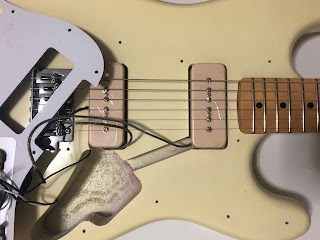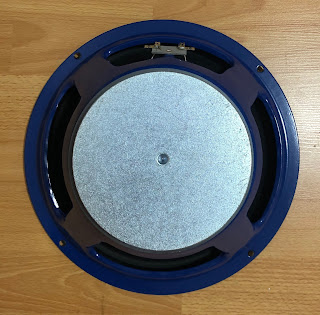I recently bought two sets of pickups from Wolfetone Pickups during their 25% off sale.
Marshallhead/Dr. Vintage
The humbucker set is an Alnico 5 Marshallhead bridge pickup (9.3k DCR) and Alnico 2 Dr. Vintage neck pickup (7.8k DCR), both in reverse zebra. The pickups were wound on the same day that I put the order in, and arrived in 6 days. I went with the 4-conductor lead option to wire these pickups for series/parallel switching. I am installing these pickups in my 2003 Ibanez SZ520QM. I previously had GFS Mean 90 pickups in this guitar. The guitar will be set up to be tuned down to D Standard.
 |
| Both pickups mounted. |
 |
| Control cavity shielded with conductive copper tape. |
I am using 500K CTS push/pull pots to perform the series/parallel switching. The diagrams that I have encountered (Stew-Mac) seem to have the humbucker wired in parallel when the pot is pushed in, which is the opposite function that I want. I will attempt to wire the pickups as shown below:
 |
| Series/Parallel Wiring of Humbuckers |
8/11/20 - I found time to complete the wiring of the humbuckers. I only had about a minute to try out the guitar through my Pro Junior to make sure all was working properly. The CTS pot switching worked as expected: pushed in for series, pulled out for parallel. I left many of the wires long for future troubleshooting/experimenting. The tone pot is a CTS 500KA with a 0.022uF orange drop capacitor. I don’t like to solder onto backs of pots, since I always burn the flux trying to get enough heat on the pot casing. I found these solder lug washers from GuitarElectronics.com, which allowed me to get a soldered connection onto a pot.
I still have D'Addario 12-52 Chromes installed from the previous configuration of the guitar. I will be trying Elixir 12-52 Nanowebs on this guitar to see how much string life I can get out of them.
 |
| Completed wiring of control cavity. |
 |
| Reinstalling the knobs and switch tip right after completing the re-wiring. |
 |
| A full shot. |
11/5/20 - I have been acclimating with the new pickups for a little while. The guitar is tuned to Drop C with Elixir Nanoweb 12-52 strings. This set has a wound G string, which I did not pick up on.
The Marshallhead is lower output than my initial expectations, but sounds great clean and with gain. The Dr. Vintage neck is clear, not flubby despite the thick strings. The output of these pickups is very low when set in parallel, but I can find uses for the sounds.
The previous combination of thick flat wound strings and P90 pickups had given me a thick sound that was fun for clean and fuzz, but limited for distorted rocksounds. The brighter nature of the current configuration allows me to fool around with downtuned heavy music without flubbing out.
Update. Marshallhead bridge pickup through Helix Native.
Marshallhead and Dr. Vintage into a Fender Pro Junior IV.
Marshallhead bridge pickup through more Helix Native amps.
Meaner P90/Mean P90
The Alnico 2 P90 soap bar set is made up of a Meaner P90 (9.3k DCR) for the bridge position and a Mean P90 (8.3K DCR) for the neck position. I will be putting the pickups in an SX Hawk, and changing out the pots from 250K to 500K, with a 0.022uF orange drop capacitor. The control cavity and pickguard will be shielded with conductive copper tape.
 |
| SX Hawk pickup route under pickguard with Wolfetone P90s mounted. |
8/13/20 - I wired up the guitar with audio taper pots. The guitar originally had linear taper volume pot, which I have gotten used to. My first observations are that the Meaner P90 bridge position is much brighter than with the stock pickups/electronics. The new pickup definitely has more output than the stock ceramic bridge pickup. The change to 500k pots could be adding the extra high end that I am not used to with this guitar. The Mean P90 in the neck position is comparable to the stock pickup from my memory.
Wolfetone Meaner P90 and Mean P90 through my Plexi-circuit 50W amp.
Edit - 12/5/23 - I bought another Meaner/Mean P90 set just as the Wolfetone sale was ending for good. These pickups went into a Squier Cabronita Baritone Telecaster. The guitar , since the sound wasn’t all that inspiring. The stock pickups sounded like P90s, but I wanted the upper midrange that the Wolfetones provided in the SX guitar.
I think the guitar sounds great now, and I keep coming back to it. The pickups sound great with gain.
While swapping the pickups out, I also shielded the pickup/control cavities with leftover copper tape to minimize noise. The guitar was rather noisy without any shielding in the cavities, and hard to tolerate with distortion. The guitar is now quiet enough to play with Plexi crunch-levels of distortion when I position of guitar in just the right magnetic position.




















